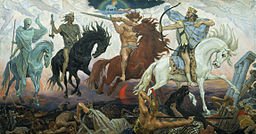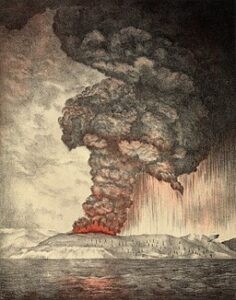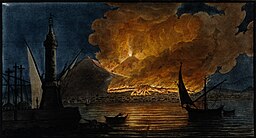The first eight verses of Revelation chapter six introduce four figures who have come to be known as The Four Horsemen Of The Apocalypse…
“Now I saw when the Lamb opened one of the seals; and I heard one of the four living creatures saying with a voice like thunder, ‘Come and see.’ And I looked, and behold, a white horse. He who sat on it had a bow; and a crown was given to him, and he went out conquering and to conquer.
When He opened the second seal, I heard the second living creature saying, ‘Come and see.’ Another horse, fiery red, went out. And it was granted to the one who sat on it to take peace from the earth, and that people should kill one another; and there was given to him a great sword.
When He opened the third seal, I heard the third living creature say, ‘Come and see.’ So I looked, and behold, a black horse, and he who sat on it had a pair of scales in his hand. And I heard a voice in the midst of the four living creatures saying, ‘A quart of wheat for a denarius, and three quarts of barley for a denarius; and do not harm the oil and the wine.’
When He opened the fourth seal, I heard the voice of the fourth living creature saying, ‘Come and see.’ So I looked, and behold, a pale horse. And the name of him who sat on it was Death, and Hades followed with him. And power was given to them over a fourth of the earth, to kill with sword, with hunger, with death, and by the beasts of the earth” (Revelation 6:1-8).
Earlier in Revelation chapter five, we read how Christ, the Lamb of God, “…came and took the scroll from the right hand of him who sat on the throne” (Revelation 5:7 NIV). Seven seals secured that scroll, and the Lamb was the only one who could open them. He will release six of those seven seals here in Revelation chapter six. The seventh and final seal will be opened later in chapter eight.
 An identical command accompanied the opening of each of the first four seals: “Come and see.” And much like the Apostle John in the book of Revelation, we are also invited to see these emerging horsemen for ourselves. But despite the vivid descriptions of these riders, their identities have been the subject of great debate down through the centuries. We’ll take a closer look at the first horseman of the apocalypse beginning next.
An identical command accompanied the opening of each of the first four seals: “Come and see.” And much like the Apostle John in the book of Revelation, we are also invited to see these emerging horsemen for ourselves. But despite the vivid descriptions of these riders, their identities have been the subject of great debate down through the centuries. We’ll take a closer look at the first horseman of the apocalypse beginning next.
Image Attribution : Viktor Vasnetsov, Public domain, via Wikimedia Commons
“And I looked, and behold, a white horse! And its rider had a bow, and a crown was given to him, and he came out conquering, and to conquer” (Revelation 6:2 ESV).
Let’s consider the first horseman described for us here in Revelation 6:2. This rider is mounted on a white horse, a traditional symbol of purity, honor, and virtue. He also carries a bow, a weapon that speaks of hunting or warfare. Our text then mentions a crown that features two items of note…
-
The first horseman did not initially possess this crown; it was given to him.
-
This crown was not a royal crown, but a wreath or garland that was typically awarded to the winner of an athletic event.
Finally, we’re told that our first horseman “…rode out as a conqueror bent on conquest” (NIV). This alludes to someone who defeats and subjugates others.
With these things in mind, let’s consider the potential identity of this horseman. For instance, some associate this rider with Jesus, based on the following passage from Revelation chapter nineteen…
“Now I saw heaven opened, and behold, a white horse. And He who sat on him was called Faithful and True, and in righteousness He judges and makes war. His eyes were like a flame of fire, and on His head were many crowns. He had a name written that no one knew except Himself. He was clothed with a robe dipped in blood, and His name is called The Word of God” (Revelation 19:11-14).
We know with certainty that Jesus is the subject of this passage from Revelation chapter nineteen, for His name is “the Word of God.” That correlates with a well-known portion of Scripture from John 1:1: “In the beginning was the Word and the Word was with God and the Word was God.” These details enable us to compare the figures mentioned in these texts…
|
Revelation Chapter Six |
Revelation Chapter Nineteen |
| Emerges from the first seal. | Emerges from heaven. |
| Rides a white horse. | Rides a white horse. |
| Possesses a bow for a weapon. | Possesses a sword for a weapon. |
| Has a single crown that signifies an athletic victory. | Has many crowns of royal authority. |
| Is a conqueror bent on conquest. | Engages in warfare with righteousness. |
Although similarities seem to exist between these figures, they are not the same. Thus, we should consider the possibility that the horseman who emerges from the first seal of Revelation chapter six is someone who resembles Jesus, but isn’t. This should also prompt us to recall Jesus’ warning from Matthew 24:23-25…
“At that time if anyone says to you, ‘Look, here is the Christ!’ or, ‘There he is!’ do not believe it. For false Christs and false prophets will appear and perform great signs and miracles to deceive even the elect– if that were possible. See, I have told you ahead of time” (NIV).
“When the Lamb opened the second seal, I heard the second living creature say, ‘Come!’ Then another horse came out, a fiery red one. Its rider was given power to take peace from the earth and to make men slay each other. To him was given a large sword” (Revelation 6:3-4 NIV).
Red is a color that is frequently used to represent conflict or war. This is the color that served to distinguish the horse ridden by the Second Horseman Of The Apocalypse here in Revelation chapter six. We should also note that this rider’s horse wasn’t simply red; it was fiery red. Furthermore, this horseman didn’t simply carry a sword; he wielded a large one, presumably with the capacity to destroy large numbers of people quickly and efficiently.
“When the Lamb opened the third seal, I heard the third living creature say, ‘Come!’ I looked, and there before me was a black horse! Its rider was holding a pair of scales in his hand” (Revelation 6:5 NIV).
The color black offers a clear association with the characteristic qualities of sadness, death, or mourning. But what do the scales held by this horseman signify? The following verse offers a potential answer…
“Then I heard what sounded like a voice among the four living creatures, saying, ‘A quart of wheat for a day’s wages, and three quarts of barley for a day’s wages, and do not damage the oil and the wine!’” (Revelation 6:6 NIV).
A quart of wheat might feed a single person for a day. Given that people commonly use scales to determine the weight of various objects, this seems to indicate that essential provisions (like bread) may be subject to rationing. So if we were to rephrase this passage in contemporary terms, we might say that these economic conditions will deteriorate to the point where people will have to labor for an entire day in order to feed themselves.
However, it also seems that such limitations will not apply to everyone during this period, for this passage also includes the following aside: “…do not damage the oil and the wine!” While oil and wine were staples of ancient life, one could get along without them if necessary. From that perspective, these items were viewed as luxuries, not necessities.
This suggests that a sizable economic divide will exist between those who can afford such things and those who cannot. Some will be subject to economic devastation during that time while others will retain the ability to maintain their self-indulgent standards of living.
“When he opened the fourth seal, I heard the voice of the fourth living creature say, ‘Come!’ And I looked, and behold, a pale horse! And its rider’s name was Death, and Hades followed him. And they were given authority over a fourth of the earth, to kill with sword and with famine and with pestilence and by wild beasts of the earth” (Revelation 6:7-8).
The fourth and final Horseman Of The Apocalypse is the only one to be named: Death. Thus, we can view this horseman as death personified. And much like a harvester that follows a reaper in a grain field, the abode of the dead (or Hades), followed behind.
Revelation 6:8 details the instruments of death employed by this horseman: the sword (or death through war and human violence), famine (or death through starvation), pestilence (or death through disease), and wild beasts of the earth (or death through an attacking animal). We’re also told “They were given authority over a fourth of the earth…” (CEB). This brief piece of information deserves more than just a cursory glance.
You see, it’s difficult to grasp the magnitude of humanity represented by twenty-five percent of the world’s population. For instance, the loss of a quarter of the global population would translate to approximately 1.5 billion people. If we were to count to that total at a rate of one number per second, it would take us over three decades to complete the task.
To put it another way, 1.5 billion people exceeds the current human population of North America, Central America, and South America combined. (1) That number is terrifying to contemplate, and puts Jesus’ message from Matthew 24:21-22 into perspective: “For then there will be great tribulation, such as has not been since the beginning of the world until this time, no, nor ever shall be. And unless those days were shortened, no flesh would be saved…”
So the Four Horsemen Of The Apocalypse depart, and the focus of our text will now shift dramatically to the souls of those who perished for their commitment to God’s Word…
“When He opened the fifth seal, I saw under the altar the souls of those who had been slain for the word of God and for the testimony which they held. And they cried with a loud voice, saying, ‘How long, O Lord, holy and true, until You judge and avenge our blood on those who dwell on the earth?’
Then a white robe was given to each of them; and it was said to them that they should rest a little while longer, until both the number of their fellow servants and their brethren, who would be killed as they were, was completed” (Revelation 6:9-11)
This passage has important implications for our beliefs concerning the afterlife. We’ll consider some of those implications next.
(1) As of 31 December, 2024. See What Is The Combined Population Of North America, Central America, And South America?
“When he opened the fifth seal, I saw under the altar the souls of those who had been slain for the word of God and for the witness they had borne. They cried out with a loud voice, ‘O Sovereign Lord, holy and true, how long before you will judge and avenge our blood on those who dwell on the earth?’” (Revelation 6:9-10 ESV).
There are those who subscribe to the belief that human beings transition to a formless oblivion when they depart from this earthly life. That realm is said to encompass a state where consciousness ends and individual identities disappear. But let’s consider that view in relation to our text from Revelation 6:9-10.
We should first note that the people described in this passage did not cease to exist at the end of their mortal lives. Equally significant is the fact that they were not absorbed into a “universal consciousness” when they passed from this life. Instead, their individual identities clearly remained. Finally, they also retained the ability to think, speak, feel, and remember. This passage thus reveals an important truth concerning the afterlife: while death may represent the end of our physical lives, it does not represent the end of us.
The presence of these souls beneath the altar suggests a link to those sacrificial offerings that were poured out at the base of the altar in the Old Testament era. In a similar manner, these individuals sacrificed their lives “…for the word of God, and for the testimony which they held” (KJV). Nevertheless, they also presented the almighty God with a forthright question: “…’Master, you are holy and faithful! How long will it be before you judge and punish the people of this earth who killed us?’” (CEV). That question led to the following response…
“Then they were each given a white robe and told to rest a little longer, until the number of their fellow servants and their brothers should be complete, who were to be killed as they themselves had been” (Revelation 6:11).
Revelation 6:11 reminds us that we may also be called upon to exercise patience when others commit injustices against us. Although patience often represents a challenging virtue, its important to recognize that God’s justice may unfold on a timetable that is influenced by factors that are beyond our immediate comprehension. Nevertheless, we can be certain that God will vindicate us if we allow Him to do so according to His divine schedule.
Therefore, we would do well to remember the truth that underlies an ancient adage: “The wheels of God’s justice grind slowly, but they grind exceedingly fine.”
“I looked when He opened the sixth seal, and behold, there was a great earthquake; and the sun became black as sackcloth of hair, and the moon became like blood. And the stars of heaven fell to the earth, as a fig tree drops its late figs when it is shaken by a mighty wind. Then the sky receded as a scroll when it is rolled up, and every mountain and island was moved out of its place.
And the kings of the earth, the great men, the rich men, the commanders, the mighty men, every slave and every free man, hid themselves in the caves and in the rocks of the mountains, and said to the mountains and rocks, ‘Fall on us and hide us from the face of Him who sits on the throne and from the wrath of the Lamb! For the great day of His wrath has come, and who is able to stand?’” (Revelation 6:12-17).
 18 May, 1980, witnessed the cataclysmic eruption of Mount St. Helens, a volcanic mountain in the western United States. Triggered by an earthquake that registered at 5.1 on the Richter scale, the lateral blast emanating from the mountain’s northern flank ripped through the surrounding landscape at an astonishing speed of 300 miles per hour (483 kph). That eruption produced a 230 square mile (370 square km) periphery of devastation that extended 17 miles (27 km) from the crater. It also produced a vertical eruption of gas and ash that reached 16 miles (26 km) into the atmosphere. 57 people lost their lives in the devastation that followed. (1)
18 May, 1980, witnessed the cataclysmic eruption of Mount St. Helens, a volcanic mountain in the western United States. Triggered by an earthquake that registered at 5.1 on the Richter scale, the lateral blast emanating from the mountain’s northern flank ripped through the surrounding landscape at an astonishing speed of 300 miles per hour (483 kph). That eruption produced a 230 square mile (370 square km) periphery of devastation that extended 17 miles (27 km) from the crater. It also produced a vertical eruption of gas and ash that reached 16 miles (26 km) into the atmosphere. 57 people lost their lives in the devastation that followed. (1)
 In the late 1800s, the Indonesian island of Krakatoa experienced a volcanic eruption that ranks among history’s most catastrophic natural disasters. Krakatoa’s eruption in August, 1883, generated devastating tsunamis up to 130 feet (40m) high. In its final stages, the noise produced by the exploding volcano was heard thousands of miles away in Australia. The immense power of the volcano’s eruption resulted in the near-total destruction of Krakatoa, along with several nearby islands. It also led to an estimated death toll of more than 36,000 people. (2)
In the late 1800s, the Indonesian island of Krakatoa experienced a volcanic eruption that ranks among history’s most catastrophic natural disasters. Krakatoa’s eruption in August, 1883, generated devastating tsunamis up to 130 feet (40m) high. In its final stages, the noise produced by the exploding volcano was heard thousands of miles away in Australia. The immense power of the volcano’s eruption resulted in the near-total destruction of Krakatoa, along with several nearby islands. It also led to an estimated death toll of more than 36,000 people. (2)
 Many centuries earlier, in 79 A.D., the eruption of Mount Vesuvius devastated the ancient Roman cities of Pompeii and Herculaneum in southern Italy. A deluge of volcanic ash and pumice stones engulfed those urban areas, prompting many residents to flee and others to seek shelter. Those who remained in Pompeii were subsequently killed when a cloud of toxic gas engulfed the city. Today, one can tour the architectural ruins of Pompeii and view casts taken of some of those individuals as they faced their final moments of life. (3)
Many centuries earlier, in 79 A.D., the eruption of Mount Vesuvius devastated the ancient Roman cities of Pompeii and Herculaneum in southern Italy. A deluge of volcanic ash and pumice stones engulfed those urban areas, prompting many residents to flee and others to seek shelter. Those who remained in Pompeii were subsequently killed when a cloud of toxic gas engulfed the city. Today, one can tour the architectural ruins of Pompeii and view casts taken of some of those individuals as they faced their final moments of life. (3)
These historical accounts should thus encourage us to approach our text from Revelation 6:12-17 with reverence and seriousness as we seek to honor God with our lives today.
(1) The Editors of Encyclopaedia Britannica. (2024, November 17). Mount Saint Helens | Location, eruption, Map, & Facts. Encyclopedia Britannica. https://www.britannica.com/place/Mount-Saint-Helens Image Attribution: U.S. government, Public domain, via Wikimedia Commons
(2) Roller, S. (n.d.). 10 Facts About the Eruption of Krakatoa. History Hit. https://www.historyhit.com/facts-about-the-eruption-of-krakatoa/ Image Attribution: Lithograph: Parker & Coward, Britain;, Public domain, via Wikimedia Commons
(3) Sullivan, M. (2024, August 23). Mount Vesuvius erupts. HISTORY. https://www.history.com/this-day-in-history/vesuvius-erupts Image Attribution: See page for author, CC BY 4.0, via Wikimedia Commons
“and the stars of the sky fell to the earth as the fig tree sheds its winter fruit when shaken by a gale. The sky vanished like a scroll that is being rolled up, and every mountain and island was removed from its place” (Revelation 6:13-14 ESV).
The meaning of the phrase “stars falling to earth” is widely debated. Theories range from stellar objects, to ballistic missiles, to the atmospheric descent of molten rock that had been propelled into the sky by volcanic activity. Then there is this reference to the sky “rolling up” and “receding like a scroll.” Many associate this idea with the image of a mushroom cloud that accompanies the use of nuclear weaponry, or the devastating impact of a cosmic object.
Regardless of the source, these horrific events led to a universal response…
“Then everyone–the kings of the earth, the rulers, the generals, the wealthy, the powerful, and every slave and free person–all hid themselves in the caves and among the rocks of the mountains. And they cried to the mountains and the rocks, ‘Fall on us and hide us from the face of the One who sits on the throne and from the wrath of the Lamb. For the great day of their wrath has come, and who is able to survive?’” (Revelation 6:15-17 NLT).
Even if we view this passage with a sense of emotional detachment, we should not overlook the dread and terror these events generated. We should also note the wide variety of individuals who shared that emotional response:
- The kings of the earth, the rulers (or government representatives).
- The generals (military personnel).
- The wealthy (those who possessed great financial resources).
- The powerful (the upper classes).
- Every slave (the lower classes).
- Every free man (a term that effectively encompasses everyone else).
So everyone, no matter what their station in life, will be affected by these events. Finally, this portion of Scripture tells us that those who were impacted by the opening of the sixth seal knew exactly who was responsible for these events as they unfolded: “…’Hide us from the one who sits on the throne and from the anger of the Lamb. That terrible day has come! God and the Lamb will show their anger, and who can face it?’” (CEV).
Instead of acknowledging their sinful behavior with an attitude of repentance, these individuals attempted to run and hide. But there was nowhere to run or hide. Thus, we should learn from their example and avoid repeating these mistakes.


